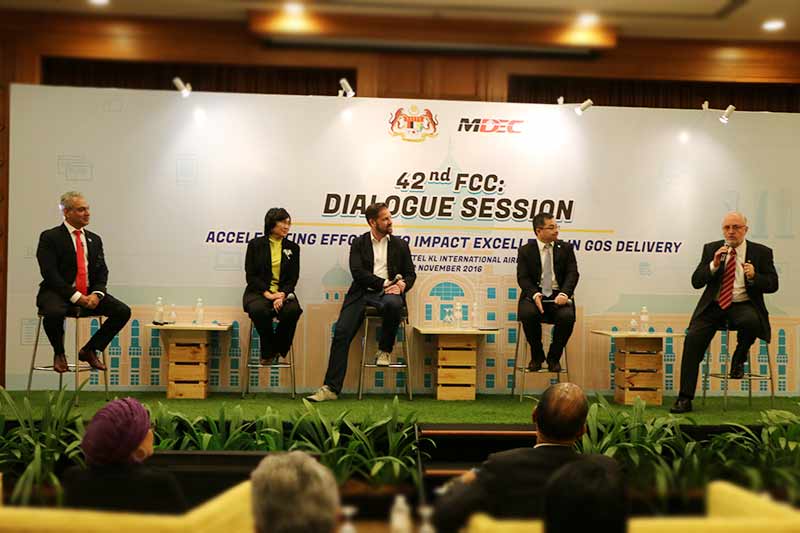
This year, there has been a common thread running through most of the conferences and dialogues, OpenGov has organised and attended. It is the mantra of citizen-centric services by government and how to design and deliver them. At the 42nd FCC (Flagship Coordination Committee) Dialogue Session on ‘Accelerating efforts to impact excellence in GOS delivery’ (GOS standing for Government Online Services), new facets were explored and critical lessons reinforced.
The international panel, moderated by Mohit Sagar (above left), Editor-in-chief of OpenGov Asia, had the following speakers (second from left to right above):
- Dato’ Yasmin Mahmood, Chief Executive Officer, Malaysia Digital Economy Corporation (MDEC)
- Stephen Foreshew-Cain, Chief Operating Officer- Digital, the Co-Op and Former Executive Director of Government Digital Services (GDS), UK
- Yao Keping, Governance and Public Administration Officer, United Nations Department of Economic and Social Affairs (UNDESA), United Nations
- Gerritt Bahlman, Director of Information Technology, Hong Kong Polytechnic University, Hong Kong
Tan Sri Dr. Ali Bin Hamsa, Chief Secretary to the Government of Malaysia opened proceedings highlighting the change in format from the usual meeting style to a more interactive session encouraging experiential learning. He said that digital disruption is here, driving the fourth industrial revolution and changing the way we live. The government must become citizen-centric and focus on enhancing the efficiency of the public sector. He expressed confidence that Malaysia would be able to deliver online services, on time, on budget and of superior quality.
Mr. Sagar started the dialogue saying that technology is only an enabler. Technology can help governments to reach the end-goals and it is those goals which we must not lose sight of. The 2016 buzzword is disruption. The other buzzword across countries is ‘citizen-centric’ service delivery.
Four questions were posed to the public sector ICT audience, to elicit their thoughts on disruption and service delivery. The responses can be seen below.

Following the questions, Mr. Sagar tried to get the panellists thoughts on what disruption meant to them. He asked Dato’ Yasmin how Malaysia is dealing with disruption. Dato’ Yasmin replied that disruption is coming in fast and furious and citizens are at the core of it. In terms of consumption of digital and online services, there is hardly any difference between Malaysia and say, the UK. Around 70% of Malaysia’s population is connected to the internet and that includes nearly 100% of the youth population. In some ways, Malaysians are even more empowered digitally. For instance, Malaysian Facebook users have 16% more friends, compared to the global numbers. The duration spent on Youtube in Malaysia is twice that of the global average.
Dato’ Yasmin continued that disruption today ranges from the ever-expanding world of IoT to the rapidly emerging areas of Artificial Intelligence (AI), Virtual Reality (VR) and Augmented Reality (AR). The Fourth Industrial Revolution is really about the convergence of the cyber and the physical worlds. Talking about innovation, she gave the example of Tesla’s recently introduced solar panels, which are cheaper by 30% than regular tiles, and as aesthetically pleasing to the eyes, if not more.
In view of all this, MDEC is trying to ensure that not only the supply side of the digital economy, comprised of investments and companies stay on course, but also that adoption is boosted.
Mr. Foreshew-Cain said that if there is one thing he could change during his tenure at GDS, it would be to go even bigger and bolder than they did. He spoke about talking to a bus company, which transports students from their home towns to universities. It had become necessary for the company to deal with digital disruption and the CEO interpreted it as the addition of Wi-Fi on the buses, and a smart ticketing system. But you don’t need Wi-Fi because almost everyone in this context will have a 4G enabled phone. And the students might realise that 3 of them can get together and rent an Uber taxi. It will pick them up, drop them exactly where they want, they can play their own music over the car’s system and have a private conversation. What the CEO failed to see was that it was no longer about buses. He had moved to the business of moving people, without realising it. If he kept thinking he was still running a bus company, the company would soon go out of business.
It is about recognising what is unique to you that will draw users to you and then finding the best way of fulfilling that need.
Mr. Bahlman defined disruption as the gap between where technology is and where people are. In his experience, the adoption of technology in teaching has been slow, notwithstanding all the rhetoric. The reason is that it is about people, teachers and students. Teachers being forced to provide electronic content to the students could be negatively disruptive to learning. Mr. Bahlman said that it was fundamentally about work practice, about the way people function. That needs to be changed before the benefits of technological disruption can be reaped. Technology is already there. People need to know how to use it.
Mr. Yao said that developments like IoT, Big Data and Artificial Intelligence are transforming the world. Government services are no longer just about services. It is about providing a platform where the government and citizens can interact and co-create. Also, service delivery needs to meet to the multi-faceted challenges posed by sustainable development goals. Protecting the environment, meeting the requirements of vulnerable groups must be factored in. In many countries around the world, the younger generation is impatient and they expect government service delivery at par with the best in the private sector, in terms of quality and response time.
Leading on from there, Mr. Sagar asked how do you create services to meet the citizens’s needs. Mr. Foreshew-Cain responded that the first step for people in government would be to recognise and keep reminding yourself that ‘you are not the user’. Governments’ assumptions about what citizens want or need is rarely backed up by data-based insights. It is important to not implement technology for its own sake but rather figure out what the desired outcomes are, which in turn should be based on what users want.

Mr. Foreshew-Cain reminded the audience that, more often than not, government has a monopoly in the services it offers. You cannot do your taxes with Apple or license your car with Google. That makes it imperative that the customers’ needs are understood clearly.
Dato’ Yasmin brought up an interesting point that once you start looking at services from the citizens’ perspective, it feels the natural thing to do. It is no longer something bold. She gave examples from MDEC’s experience. The traditional approach was to define the scope according to what the agency thought its customers wanted and then tendering for a big project, and executing it.
Even if the agency had it completely right, by the time it was implemented, it had been superseded by different user needs or new technology. It turns into a vicious cycle. MDEC’s first CIO, Abdul Malick Aboobakar, initiated agile development based on continuous feedback from users and 30-day iterative cycles (OpenGov recently wrote about the initiatives at MDEC in detail). It is much faster and costs a fraction of the old approach.
Mr. Sagar moved the conversation to the issue of culture holding back innovation in Asia and posed a question on how to overcome it. Mr. Bahlman shared his experience of introducing virtual desktop environment at his University. As government, you cannot afford it to get it wrong. It could develop into a political bombshell, with wide ramifications. The situation is similar in a university. As a result, his staff were scared of taking any risks.
Mr. Bahlman then took a new approach. They decided to explain to the users what they were trying to do and to tell the users that it would not work right the first time and then to provide a mechanism to the users to tell the IT team how to make it right. Users were offered incentives to complain, to point out flaws in the implementation. This combination of transparency and empowering the users, freed the IT team to try out something new and encouraged users to try it.

Mr. Foreshew-Cain said that the fear of failure was due to potentially wasted public resources and because of the criticality of the services.
A 1000 ideas can funnel down into maybe a 100 prototypes, then 10 products tested with real people and finally 1 product that is rolled out. This 1000:100:10:1 path is the anti-thesis of how the government looks at risk. The idea should be to start small and to show that it can be done better. The strategy is delivery.
There was a question from the audience on driving community engagement. Connectivity does not always equal engagement. Dato’ Yasmin said that many digital business models are dependent on getting people on to their platform and engaging them. This is true for the internet giants, as well as, start-ups. Governments could learn digital marketing skills from them, especially for reaching the millennials. Also, every single customer on a platform expects their experience to feel one-to-one, to be personalized. They don’t care if there are a million other users on the platform at the same time. Data analytics can be used to deliver the required kind of personalized experiences.
The dialogue progressed to predictive data analytics. Mr. Yao gave the example of tracking social media talk of a certain disease or medicine, through which government could anticipate an epidemic and prepare for it. Or tracking numbers and movements of citizens in a sensitive, crowded area using telecom signals and use it to prevent a stampeded like the one which happened in Shanghai in 2014.
Mr. Sagar rightly pointed out that these kind of actions would require government agencies to talk to each other. That can prove a daunting challenge at times. So, how do we accomplish that feat?
Mr. Foreshew-Cain replied that one way could be to find unifying factors, things which happen many times, across government. That was what GDS did. For example, making payments, issuing licenses, notifying citizens. Although there would be context-specific component, the commonalities can be enough to bring departments or agencies together on a common platform.
There is often a cultural desire to localise information. To overcome that, GDS built a performance platform, where real time data was published about the performance of public services, online and offline. Any citizen, any civil servant or any politician could log on at any time and check things like the time taken to answer a query over a phone call about licenses. Firstly, it highlighted the problems. Secondly, it created envy, not fear. Something desirable was created, which encouraged government departments to share data.
Dato’ Yasmin said that Malaysian government agencies were working towards both increasing the number of open data sets, accessible to the public and on enhancing sharing of data which is not open but should be shared between agencies. It is hindered by fears over confidentiality and privacy.
The ultimate objective is to create a common data ocean. But there is a long way to go in terms of implementation.
Mr. Sagar said that when it comes to privacy concerns, trust in government must be built up. Mr. Bahlman talked about the contrast between people’s willingness to share information with the private sector and their apprehensions when it comes to doing the same with government. The government needs to be clear about what the data is going to be used for and how it is going to be exchanged between departments.

Mr. Yao added that building trust in government is a long process. Governments need to demonstrate and assure citizens that their data is safe with them. As for breaking organizational silos, he said strong leadership is required, with CIOs setting targets and deadlines and following them. Back-office data coordination is required, and it has to be ensured that data is machine readable and that machines can talk to each other.
As conversation wound down towards conclusions and a moving back to the initial points about the importance of citizen-centric services, Mr. Yao said that citizens should not have to understand complex, hierarchical structures within government. Their interaction with e-government should be as simple as possible. This tied in with Mr. Foreshew-Cain’s explanation of the GDS strategy to just sort it out for the users. Which would have contributed to the UK’s ranking at the top of the UN E-Government Survey 2016.
Mr. Foreshew-Cain concluded saying spent 80% of his time in finding out customers’ needs and 20% of the time taking decisions. The other thing is the necessity of breaking problems down. Governments and citizens often assume that government is too big and complicated to fix. But government is important, but it is often not big. A mid-sized internet venture would be processing more online transactions than entire governments. Technologies are available today to build and deliver services in simpler ways. So, listen and then simplify, simplify and simplify.
















